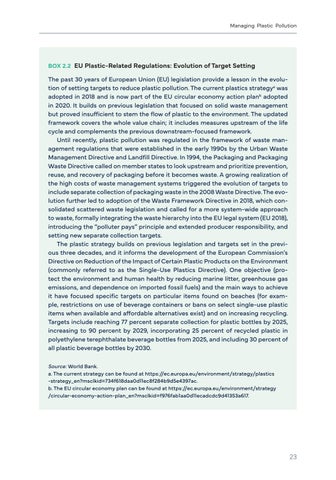Managing Plastic Pollution
BOX 2.2 EU Plastic-Related Regulations: Evolution of Target Setting
The past 30 years of European Union (EU) legislation provide a lesson in the evolution of setting targets to reduce plastic pollution. The current plastics strategya was adopted in 2018 and is now part of the EU circular economy action planb adopted in 2020. It builds on previous legislation that focused on solid waste management but proved insufficient to stem the flow of plastic to the environment. The updated framework covers the whole value chain; it includes measures upstream of the life cycle and complements the previous downstream-focused framework. Until recently, plastic pollution was regulated in the framework of waste management regulations that were established in the early 1990s by the Urban Waste Management Directive and Landfill Directive. In 1994, the Packaging and Packaging Waste Directive called on member states to look upstream and prioritize prevention, reuse, and recovery of packaging before it becomes waste. A growing realization of the high costs of waste management systems triggered the evolution of targets to include separate collection of packaging waste in the 2008 Waste Directive. The evolution further led to adoption of the Waste Framework Directive in 2018, which consolidated scattered waste legislation and called for a more system-wide approach to waste, formally integrating the waste hierarchy into the EU legal system (EU 2018), introducing the “polluter pays” principle and extended producer responsibility, and setting new separate collection targets. The plastic strategy builds on previous legislation and targets set in the previous three decades, and it informs the development of the European Commission’s Directive on Reduction of the Impact of Certain Plastic Products on the Environment (commonly referred to as the Single-Use Plastics Directive). One objective (protect the environment and human health by reducing marine litter, greenhouse gas emissions, and dependence on imported fossil fuels) and the main ways to achieve it have focused specific targets on particular items found on beaches (for example, restrictions on use of beverage containers or bans on select single-use plastic items when available and affordable alternatives exist) and on increasing recycling. Targets include reaching 77 percent separate collection for plastic bottles by 2025, increasing to 90 percent by 2029, incorporating 25 percent of recycled plastic in polyethylene terephthalate beverage bottles from 2025, and including 30 percent of all plastic beverage bottles by 2030. Source: World Bank. a. The current strategy can be found at https://ec.europa.eu/environment/strategy/plastics -strategy_en?msclkid=734f618daa0d11ec8f284b9d5e4397ac. b. The EU circular economy plan can be found at https://ec.europa.eu/environment/strategy /circular-economy-action-plan_en?msclkid=f976fab1aa0d11ecadcdc9d41353a617.
23





